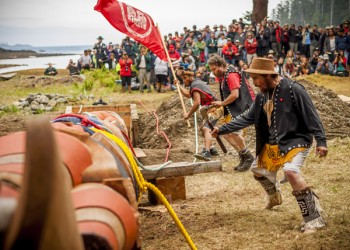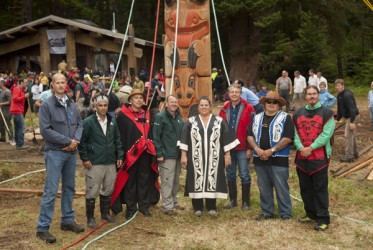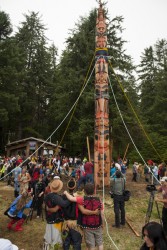Article Origin
Volume
Issue
Year
The Legacy Pole is considered by the Haida Nation as a significant creation, but it is personal for carver Jaalen Edenshaw and Haida Nation President Peter Lantin.
Edenshaw, whose design and story was chosen by a committee to commemorate 20 years of the Haida Nation and Canada working together, recalled attending meetings with his father leading up to the Lyell Island logging blockades of 1985.
“But also in my design I was recognizing those who stood on the line for Gwaii Hanaas back in 1985. That was really important to me,” he said.
Lantin’s grandmother was one of those people who stood on the line protesting the logging of the traditional territory. She was one of four Elders to be arrested for her participation.
The Lyell Island blockade led to the creation of the protected area of Gwaii Hanaas National Park Reserve, the National Marine Conservation Area Reserve and the Haida Heritage Site, managed by the Archipelago Management Board, which consists of members from the Haida Nation and the federal government.
Also established was the Gwaii Trust Fund of more than $100 million, from which Haida Nation members continue to benefit.
“This approach was built on conflict and we’re now in an era where it’s not conflict. We’re trying to reconcile our differences and benefit everyone that lives in Haida Gwaii,” said Lantin.
On Aug. 15, about 400 people made the three-hour trip by speed boat, or eight hours by fishing boats, to the remote site of Hlk’yah G aaw G a, on Lyell Island, for the first pole, the Legacy Pole, to be raised on the now-abandoned village site in 130 years.
Fifty of Edenshaw’s family members boarded a crab boat, leaving home from the northern end of the island at 3 a.m. for what turned into an eight-hour trip.
“It was a pretty good feeling to see them all come off that boat, all my cousins, my friends. Quite a commitment for them to travel,” he said.
It took Edenshaw, with the help of brother Gwaai Edenshaw and nephew Tyler York and a handful of others, close to one year to carve the 42-foot, 500-year-old red cedar pole. Representing the story of the Haida people are 17 figures. That story includes a Sculpin (a bottom-feeding fish) at the base of the pole and an eagle, fastened to the top of the pole. This scene signifies the original agreement, which offered protection of the area from the ocean-floor to the mountaintop.
Another figure, a grizzly bear, is a reminder of tales told of a life that no longer prowls the island. Parks Canada archaeologists recently found grizzly bear bones dating back to 14,000 years. There is also a carving of the Sacred-One-Standing-and-Moving, added after Edenshaw had started working on the pole.
“That story caused me a little more work because I had just started carving,” said Edenshaw. “The earthquake (in 2012) shut down the hot springs down in Gwaii Hanaas and I thought that was a story worth telling.”
While work on the pole proceeded at a steady rate, Edenshaw said, as the time neared for the celebration, he and his team had to “step up the work a bit and started doing 12-hour days near the end.”
It took 100 people to raise the pole, which was towed to the village site on a barge.
“It was kind of bitter-sweet. It was very emotional to set foot back on the land where the Haida Nation finally took a stand. There was a lot of pride,” said Lantin. It was the first time he, and many of his generation, had been on the island.
The Legacy Pole will be a permanent reminder of what was accomplished over the years, said Ernie Gladstone, superintendent of Gwaii Hanaas National Park Reserve and member of the Archipelago Management Board. Historic poles still stand in the villages of SGang Gwaay and Skedans.
“But they’re not going to be there forever. They’re going to return to the ground where they came from and it’s important that we continue with traditional activities in that area, so this pole is doing just that,” said Gladstone.
Lantin points out that the Haida Nation presently has a case in front of the court fighting for title of the land. But while Canada and the Haida Nation disagree on who holds title, they are still working together to protect the land.
- 1876 views



